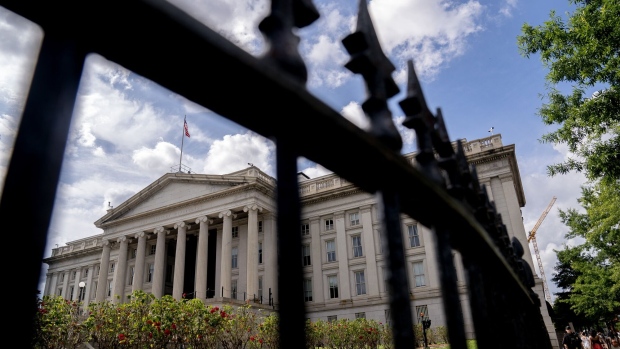May 3, 2023
First US Treasury Buybacks in Decades Aim to Spur Liquidity
, Bloomberg News

(Bloomberg) -- The US Treasury’s unexpectedly quick rollout of a program to buy back some outstanding debt securities suggests officials hope it will improve trading in the world’s biggest bond market.
The Treasury on Wednesday said that it will begin “regular and predictable” purchases of Treasuries sometime in the 2024 calendar year in the first buyback program since 2000.
Most dealers hadn’t expected an announcement so soon, amid continuing discussions between officials and market participants over how a program would be structured.
Unlike the last time, the new plan isn’t a side-effect of budget surpluses. The Treasury launched the previous initiative as a way of retiring some outstanding, higher-interest securities as it enjoyed an historic period of tax revenues outpacing spending.
Today, the federal government is running large deficits. But other challenges have cropped up in the $24 trillion Treasuries market. One is that regulations put in place after the global financial crisis requiring banks to set aside capital against Treasuries trading have left them less willing to engage in market-making.
Vulnerable Market
Analysts say that’s left the market vulnerable to bouts of illiquidity, especially for Treasuries that are no longer the current benchmarks — so-called off-the-runs.
One of the two main aspects of the new buyback program will be to support liquidity, by purchasing older outstanding securities and selling more of current benchmarks.
The second main purpose, the Treasury said in Wednesday’s statement, will be to help with “cash management.” The Treasury Borrowing Advisory Committee, or TBAC — a panel of investors, dealers and other market participants that regularly counsels the Treasury — has highlighted that the department’s sales of Treasury bills can be volatile as revenues and outlays fluctuate.
When the Treasury receives a big influx of revenue, as with tax receipts when annual filings are due in April, its cash balance surges and it cuts back its bill issuance. A buyback program would offer the Treasury the option of smoothing out bill issuance, while using large inflows of cash for buybacks.
“Operations will likely split into two categories: liquidity support for longer maturities (greater than one year), and cash management for maturities up to two years” Deutsche Bank AG Steven Zeng wrote in a note to clients.
The Treasury said that buybacks will “initially sized conservatively, and not intended to meaningfully change the overall maturity profile of marketable debt outstanding.” It added it will conduct more consultations.
Fed Stockpile
Stephen Stanley, chief US economist at Santander US Capital Markets LLC, noted that TBAC had indicated that the Treasury discussed “proposed sizing of ‘up to $240 billion per year,’ but it sounds like it would begin smaller and ramp up to that.”
Stanley said that Santander’s trading desk has highlighted one challenge: During its pandemic-driven quantiative easing program. the Federal Reserve amassed such a large stockpile of Treasuries that there may be limited volumes available of short-dated interest bearing securities for the Treasury to buy back.
Zeng at Deutsche Bank still suggested the program might help. It could achieve an outcome of “enhancing Treasury market liquidity especially for off-the-runs,” he wrote.
--With assistance from Alexandra Harris and Liz Capo McCormick.
©2023 Bloomberg L.P.






